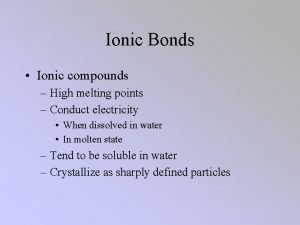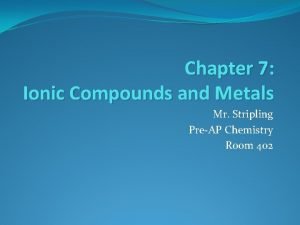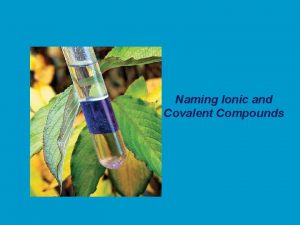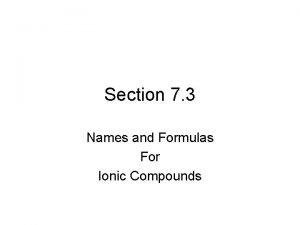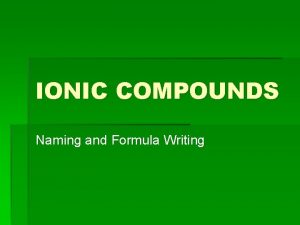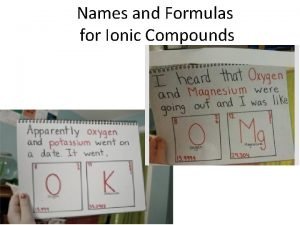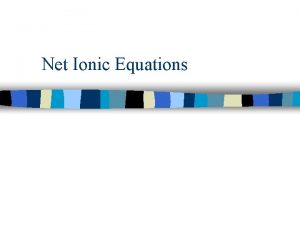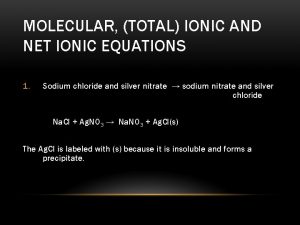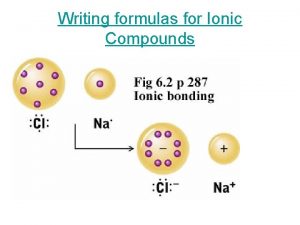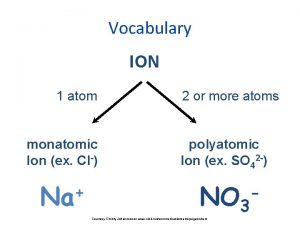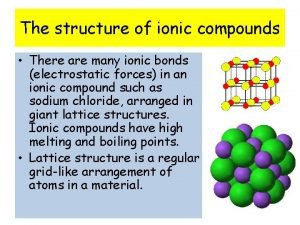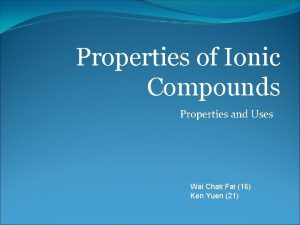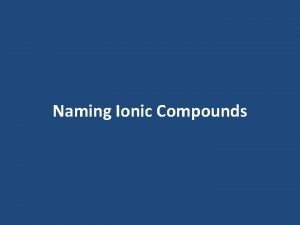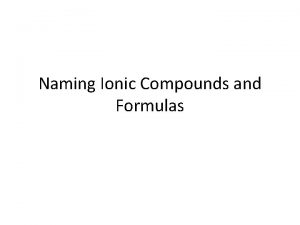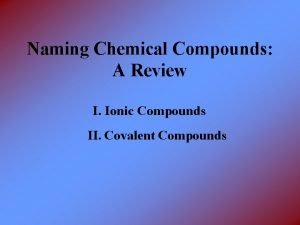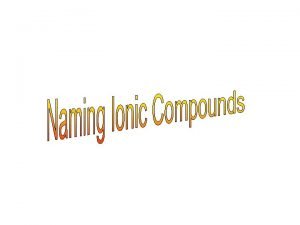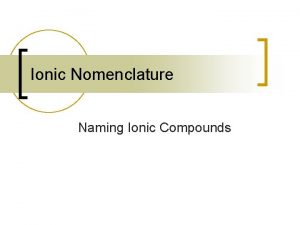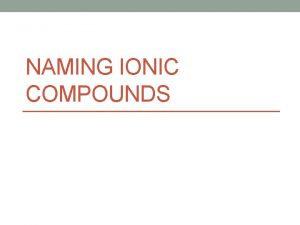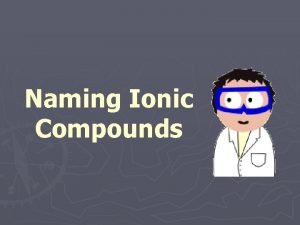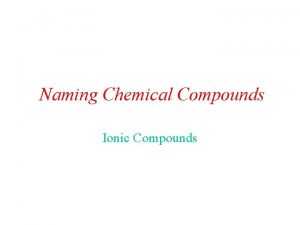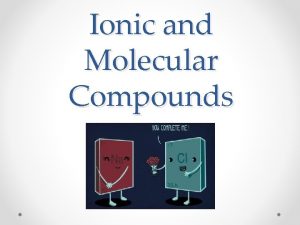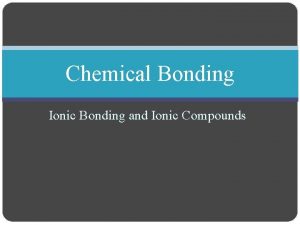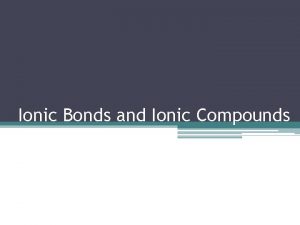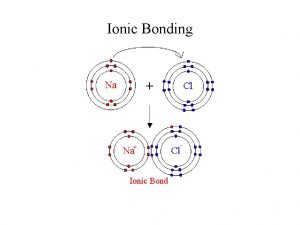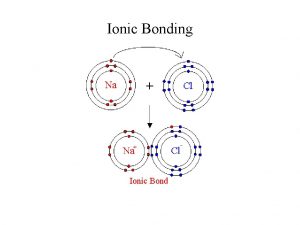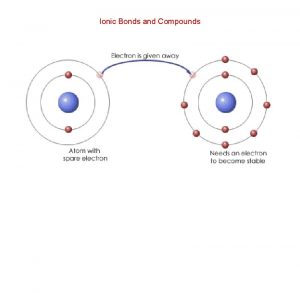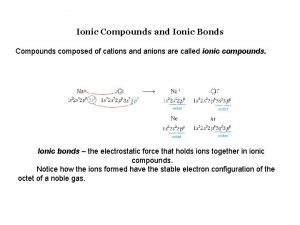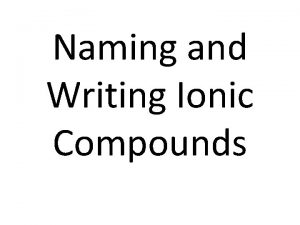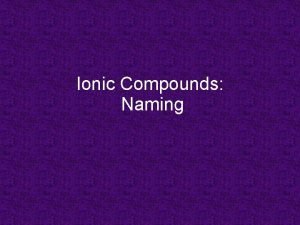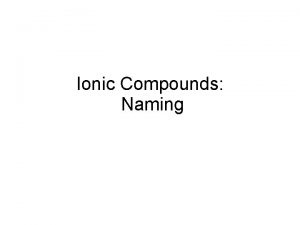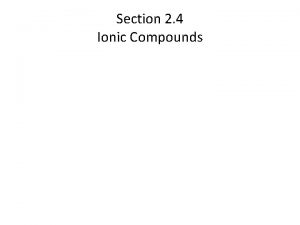Compounds Molecular and Ionic Molecular Compounds o Molecular
























- Slides: 24

Compounds Molecular and Ionic

Molecular Compounds o Molecular compounds n n n have relatively melting points and boiling points do not conduct electricity when may or may not conduct electricity when

Molecular Compounds o Molecular compounds n n n exist as with definite composition have individual molecules that are held together by relatively that are generally proportional to the size of the molecule for the binary compound AB, the A is attracted than to other B’s

Molecular Compounds B o A Imagine that these are binary molecular compounds where the red end represents element A and the white end represents element B. A is attracted to all B’s but to one B more than the others

Molecular Compounds o Law of Definite Proportions: In a given compound, the elements are combined in a n This means that for something like water, H 2 O, there always 2 H’s for every 1 O. There can never be water with 3 H’s for every 1 O or 2 H’s for every 3 O’s.

Molecular Compounds o Law of Multiple Proportions: When elements form more than one compound, the mass ratio of one element to the other in a compound is an of the ratio in another n n n Mass O : Mass C in carbon monoxide is 1. 33: 1 Mass O : Mass C in carbon dioxide is 2. 67: 1 This makes sense, since there is in CO 2 as in CO

Binary Molecular Compounds o o A binary molecular compound is composed of two To name a binary molecular compound, it is necessary to use

Binary Molecular Compounds o Naming the first element: n n o Only use a prefix if there is of the first element atom of the element’s name Naming the second element: n n use a prefix of the element’s name

Binary Molecular Compounds o The prefixes are: n n n 1 -mono 2 -di 3 -tri n 5 -penta 6 -hexa 7 -hepta n n n 9 -nona 10 -deca

Binary Molecular Compounds o Name these compounds: n n o CCl 4 P 2 O 5 Give the formula for these compounds: n n dinitrogen monoxide oxygen difluoride

Ionic Compounds o Ionic compounds n n n have melting points and boiling points conduct electric current when in

Ionic Compounds o Ionic compounds n n have a basic unit that is a of oppositely charged particles called have empirical formulas giving the simplest integer ratio of the ions in a o Na. Cl is not a molecule but a series of Na+ ions surrounded by Cl- ions n n Each Na+ ion is attracted equally by Each Cl- ion is attracted equally by Cl- ions Na+ ions

Ionic Compounds o o This is a crystal lattice of Na. Cl, a common ionic compound Every Na+ ion (green) is surrounded by 6 Cl(blue) ions

Ionic Compounds o This website will show a Na. Cl unit cell repeats to form a crystal lattice. http: //departments. kings. edu/chemlab/animati on/nacl. html o Are there individual molecules in an ionic compound?

Ions o Ions are neutral atoms that have gained or lost electrons to develop a charge n Metals n Nonmetals called to form positive ions called to form negative ions

Ionic Charges o Representative elements have predictable charges

Ionic Charges o The transition metals may have multiple charges

Ionic Charges o o Transition metals and those representative metals that are under the stair-step line may have possible charge To differentiate between them, you must use a n Example: Cu 1+ is copper (I) and Cu 2+ is copper (II)

Binary Ionic Compounds o o o Binary ionic compounds consist of ions— a cation which is a metal and an anion which is a nonmetal. Binary ionic compounds only contain The ions’ charges must cancel in order to create a formula unit

Binary Ionic Compounds o Let’s say that you wanted to combine the metal Sr with the nonmetal I. n First, you would have to Sr and the charge on I o o n on Sr is in Group 2 and has a charge of I is in Group 17 and has a charge of Then, you would have to make sure the charges o It would take two I 1 -’s to cancel one Sr 2+:

Naming Binary Ionic Compounds o Name the cation/metal first n NEVER use prefixees n the ending If there are multiple charges, use a n o Name the anion/nonmetal second n n NEVER use prefixes Change the ending to

Naming Binary Ionic Compounds o Name the following compounds: n n n o Li. F Mg. Cl 2 Cu 3 N Give the formulas for the following compounds: n n calcium sulfide iron (III) oxide

Naming Ternary Ionic Compounds o Name the cation first n n n o Is it a polyatomic ion? If so, name it. Is it a monatomic ion? If so, check to see if it needs a and then name it. Remember, metal’s endings do not change! Name the cation second n n Is it a polyatomic ion? If so, name it. Is it a monatomic ion? If so, change the ending to.

Naming Ternary Ionic Compounds o Name the following compounds n n n o Na 2 SO 4 NH 4 CO 3 Al(NO 3)3 Give the formula of the following compounds n n lead (II) acetate calcium carbonate
 Ionic covalent and metallic bonding
Ionic covalent and metallic bonding Charges of compounds
Charges of compounds Ionic bond melting point
Ionic bond melting point Chapter 7 ionic compounds and metals
Chapter 7 ionic compounds and metals Chapter 7 ionic compounds and metals assessment answer key
Chapter 7 ionic compounds and metals assessment answer key Covalent compound hi
Covalent compound hi Section 3 names and formulas for ionic compounds
Section 3 names and formulas for ionic compounds Di vs bis
Di vs bis Section 3 names and formulas for ionic compounds
Section 3 names and formulas for ionic compounds Chapter 7 chapter assessment ionic compounds and metals
Chapter 7 chapter assessment ionic compounds and metals Chemistry chapter 7 ionic and metallic bonding
Chemistry chapter 7 ionic and metallic bonding Pb(no3)2 + ki
Pb(no3)2 + ki Molecular total and net ionic equations
Molecular total and net ionic equations Writing formulas (criss-cross method)
Writing formulas (criss-cross method) Ternary ionic compounds
Ternary ionic compounds Monatomic ion
Monatomic ion Brittle
Brittle Molar solubility
Molar solubility Ionic compound
Ionic compound P2o5 compound name
P2o5 compound name Chemical
Chemical Naming hydrates
Naming hydrates Ternary ionic compounds
Ternary ionic compounds How to name ionic compounds
How to name ionic compounds Binary ionic compounds
Binary ionic compounds


